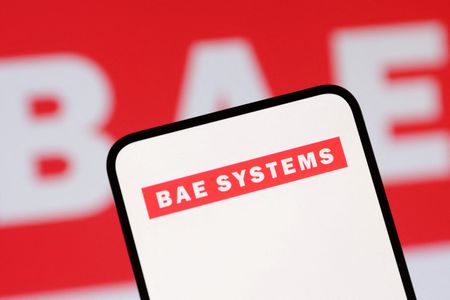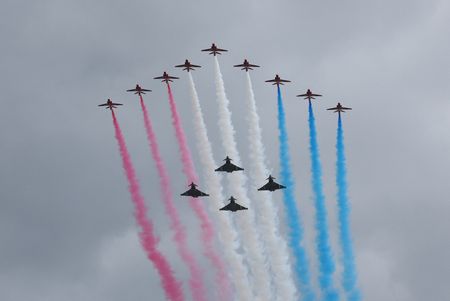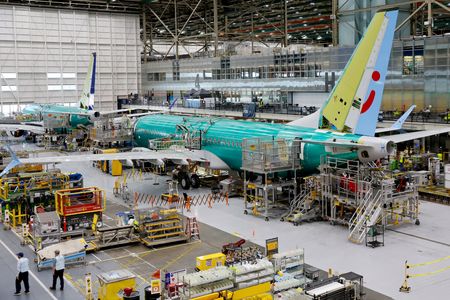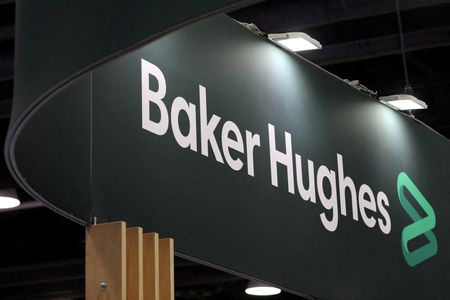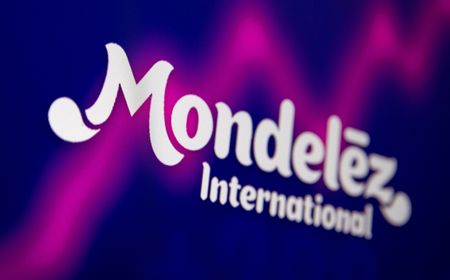By Tim Hepher and Sarah Young
PARIS/LONDON (Reuters) -Boeing and Sweden’s Saab are in talks with Britain’s BAE Systems about teaming up on a future replacement of Britain’s Hawk trainer in a growing niche of the fast jet industry, three people familiar with the matter said.
Boeing and Saab have jointly developed the T-7 advanced trainer for the U.S. Air Force, while Britain has said it plans to replace its out-of-production Hawk fleet, part of which is instantly recognisable through its Red Arrows display team.
Proposals are at an early stage and details are still to be worked out, with no guarantee that an agreement can be reached, one of the sources said.
“We don’t comment on rumour and speculation,” said a spokesperson for BAE Systems, whose corporate predecessor developed the successful Hawk trainer in the early 1970s.
“Training remains an important pillar of our air sector strategy. We continue to explore and develop our footprint in this area across both live and synthetic capabilities.”
A Saab spokesperson said: “We have a long-term partnership with Boeing on the co-development of T-7. Saab will not comment on rumours or speculation.”
Boeing had no immediate comment.
In June, a UK defence strategy review recommended that the Hawk be replaced, and the government said it would welcome interest from UK-based suppliers.
BAE has said it has not decided whether to develop a new jet to replace the Hawk, whose production line closed in 2000.
RED ARROWS
It was not immediately clear whether any potential co-operation would be restricted to the UK contest or eventually seek to take advantage of BAE’s incumbency in the wider export market, where over 1,000 Hawks have been sold to 18 nations.
One of the sources said it was premature to think beyond the British competition.
Demand for nimble trainers is rising.
According to U.S.-based consultancy AeroDynamic Advisory, the market for military trainer aircraft is expected to rise to $3.7 billion in 2030 from $2.8 billion, excluding substantial related spending on support, sustainment and training services.
Key suppliers include the Boeing-Saab T-7, Leonardo’s Aermacchi M-346 and the Korea Aerospace Industries T-50 Golden Eagle.
Aeralis, a privately owned early-stage British company, has designed a new jet trainer that it says could replace the Hawk.
Some analysts have expressed concerns, however, that the case for an all-new fleet is being driven in part by Britain’s Red Arrows, a diplomatic symbol abroad and a popular feature of royal events at home. Their jets are due to retire in 2030.
UK publication Defence Eye reported last week that Britain is looking at buying a first batch of new trainers over the next five years to replace the Red Arrows’ Hawk T1s, followed by a larger second batch of T2 replacements in the late 2030s.
“A major complicating factor is the need for the Red Arrows aircraft to be British-designed, or at least British-assembled, to allow the aircraft to act as a promotional tool for the UK aerospace industry,” the report by UK defence expert Tim Ripley said.
The choice of trainer also has potential implications in the bigger global market for fighter jets.
Britain’s defence committee has warned the T2 will not meet training requirements for future fighters envisaged by Britain, Japan and Italy known as the Global Combat Air Programme (GCAP).
For Boeing and Saab, a UK sale would not only provide a key European market, but could potentially mean getting a toe-hold in the training requirements for GCAP and generate potential future trainer business from exports of the combat jet.
For BAE, having a ready-made trainer could be one extra marketing point for its future combat jet system, Ripley said.
“It would increase the value that you can export with GCAP,” he told Reuters.
On the other hand, analysts say BAE’s existing Italian partner in GCAP, Leonardo, is likely to press the industrial and strategic case of its own M-346 as the GCAP trainer of choice.
Leonardo could not immediately be reached for comment.
(Reporting by Tim Hepher and Sarah Young, Additional reporting by Mike Stone; Editing by Susan Fenton and Jan Harvey)

